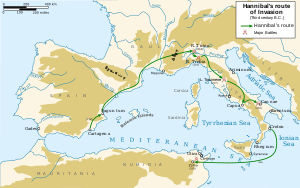
Back عبور حنبعل لجبال الألب Arabic Поход на Ханибал през Алпите Bulgarian Pas dels Alps Catalan Hannibals Alpenüberquerung German Cruce de los Alpes Spanish Passage des Alpes par Hannibal French מסע חניבעל לחצי האי האפניני HE Passaggio delle Alpi di Annibale Italian ハンニバルのアルプス越え Japanese Travessia dos Alpes por Aníbal Portuguese
| Hannibal's crossing of the Alps | |||||||
|---|---|---|---|---|---|---|---|
| Part of the Second Punic War | |||||||
 Hannibal's route to Italy | |||||||
| |||||||
| Belligerents | |||||||
|
|
| ||||||
| Commanders and leaders | |||||||
|
Hannibal Hasdrubal Mago Hasdrubal Gisco Syphax Hanno Hasdrubal the Bald Hampsicora Maharbal |
Publius Cornelius Scipio Tiberius S. Longus | ||||||
Hannibal's crossing of the Alps in 218 BC was one of the major events of the Second Punic War, and one of the most celebrated achievements of any military force in ancient warfare.[1]
Hannibal led his Carthaginian army over the Alps and into Italy to take the war directly to the Roman Republic, bypassing Roman and allied land garrisons, and Roman naval dominance.
The two primary sources for the event are Polybius and Livy, who were born c.20 years and c.160 years after the event, respectively.[2] The Alps were not well-documented at the time, and no archaeological evidence is available, so all modern theories depend on interpreting the three place names used by Polybius (Island, Skaras, and Allobroges) and Livy's wider range of tribe and place names, and comparing them with modern geographical knowledge.[2]
- ^ Lancel, Serge, Hannibal, p. 71
- ^ a b Yardley, J.C.; Hoyos, D. (2009). Hannibal's War: Books 21-30. OUP Oxford. pp. 620, 629. ISBN 978-0-19-955597-0.
Hannibal crossed the Alps by one of the western passes, arriving in the territory of the Insubres according to Polybius (3.56), but the Taurini according to both Livy (21.38) and, it seems, Polybius himself later on (see below). Polybius does not identify the pass; Livy (ibid.) discusses the question briefly but only to dismiss the Poenine pass, or Great St Bernard, and the Cremo, or Little St Bernard. His arguments are sensible, but he does not then say which pass, if any, he himself thinks was the right one. The Alps had not been mapped or even extensively visited by Greeks and Romans before 218. So we cannot say how precise were the accounts of the primary sources (on whom see Introduction). Our main authorities are Polybius and Livy. Polybius reports that he himself visited the area and questioned eyewitnesses (3.48); but such persons must have been very old by then, and relying chiefly or wholly on their memories. He must also be using some or all of the primary sources. Livy evidently combines Polybius' account with at least one other; or, less likely, reproduces a predecessor who did the combining. Both mention relatively few place names after Hannibal's crossing of the Rhône, and not all are readily identifiable. With no archaeological evidence available, every theory thus depends on interpreting these accounts and comparing them with existing topography. Unsurprisingly, theories abound (see Further Reading below) and none has won universal acceptance.... Polybius' distance-reckonings look like broad estimates, when not guesstimates... We may note how important Livy's non-Polybian contribution is. From the Rhône-crossing to the descent into Italy, Polybius supplies three names: Island, Skaras, and Allobroges. It is Livy's range of tribe- and place names, despite the faults, that makes practicable any attempt to reconstruct Hannibal's route over the Alps.